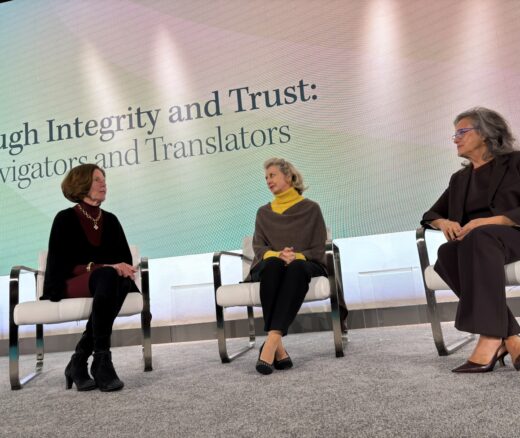
When Medicare Sent Patients Home Sooner, Mary Naylor Built the Safety Net
Her Transitional Care Model Shows How Nurse-Led Care Can Keep Older Adults Out of the Hospital and Change Care Worldwide
Improving Care for Older Adults
Blog Post

Produced in conjunction with the Population Aging Research Center at the University of Pennsylvania.
Half of hospice family caregivers report unmet communication needs, which can result in difficulties managing pain and symptoms, increased use of emergency departments, heightened caregiver stress, and more.

In addition, the number of distance caregivers—adults caring informally for family members not living in the same residence—has grown to an estimated 4.6 million in the United States. Distance can further disrupt the exchange of information and reduce opportunities to interact with clinical teams. Yet these interactions are essential. Communications that are consistent, direct, and sensitive to the family’s needs are key to ensure that patients receive high-quality care.
However, as the prevalence of distance caregivers increases, little is known about how caregiver proximity influences perception of hospice communication. In a new Health Communication study, LDI Associate Fellow Lauren Starr, LDI Senior Fellow George Demiris, and colleagues explore how caregivers’ perceptions of communication effectiveness worsen with distance, and posit potential solutions.
We asked Starr and Demiris about their study and findings.
It is typically easier for family caregivers to attend hospice visits when they live with the person receiving hospice care. Conversations about the patient’s needs, the caregivers’ needs, and opportunities to teach caregivers how to manage symptoms or administer medications happen more organically in person. Of course, hospice teams try to communicate with caregivers who do not live with the patient or cannot attend appointments, usually over the phone. But the frequency and depth of the communication may differ. Knowing the best ways to communicate with the hospice team members can be confusing for family caregivers in general, but especially for those who live far away. There is not always a single hospice point person for the family to contact, so distance caregivers sometimes rely on secondhand reports from in-person caregivers, which influences the information they receive.
Caregivers and hospice teams discuss the physical symptoms experienced by the patient, such as pain or discomfort, difficulty breathing, constipation, or diarrhea. They also cover methods to manage symptoms, including how to administer medication or incorporate non-pharmacological interventions like music therapy or light touch. Changes in the patient’s ability to walk or do activities they usually enjoy, nutritional intake, and sleep are also reviewed, along with emotional and spiritual experiences. Hospice family caregivers experience high rates of anxiety, depression, and sleeplessness, so their coping mechanisms and any questions they may have are also addressed. All of this information informs the patient’s care and the family’s confidence in managing the care once the hospice team leaves. Real-time communication during these appointments is extensive, so it is not surprising that details are lost when visits are summarized in a follow-up telephone call.
Hospice family caregivers who don’t co-reside have less adequate information exchange, relationship development, emotional responsiveness, care management, and decision-making communication in hospice care than co-residing caregivers. This is an important and novel finding because it highlights a critical opportunity for hospice teams to improve communication with caregivers who do not co-reside—especially as distance caregiving becomes more common. Without effective communication, care quality can be compromised, and caregivers can feel dissatisfied, frustrated, and anxious. In addition, we found older caregivers rated hospice communication more favorably than younger caregivers, which may point to opportunities for communication interventions that better meet the needs of younger caregivers, who are more likely than older caregivers to be employed or caring for their own children.
Caring for a person who is dying can be emotionally and physically difficult. Many factors contribute to communication difficulties, including caregiver stress, fatigue from poor sleep, problems with health literacy and hospice literacy (i.e., understanding what hospice does), language barriers, cultural differences, and problems with attending hospice home visits in person (e.g., due to work schedules or distance). When caregivers do not reside with the patient, geographic distance and time constraints may impose additional barriers. Like other clinicians, hospice teams typically serve multiple patients in a day and due to shift changes do not always offer a single point person for family communication, leading to possible gaps in communication.
Developing tools that improve communication between clinicians and caregivers, without increasing hospice team workload, is already a challenge. We also need to develop tools that make distance communication easier for both clinicians and caregivers. The recent pandemic accelerated the use of video conferencing for many aspects of daily living, including work and health care. Telehealth and web-based technology may ease stressors associated with distance caregiving by improving timeliness and frequency of communication between caregivers and clinicians, increasing access to health services and improving efficiency, promoting caregiver engagement, and reducing caregiver anxiety and distress. Technology can support the “virtual” presence of caregivers during hospice visits and the inclusion of both patient and caregivers in hospice team meetings.
Further research is needed to better understand why non- co-residing caregivers perceive hospice communication less favorably and whether caregivers’ level of care involvement, which may relate to caregiver distance and comfort discussing caregiving, are related to perceptions of hospice communication quality. Also, further exploration of how health literacy, hospice literacy, social determinants of health, and other factors play a role in hospice communication quality and satisfaction is needed.
Our next steps include using a scale we have developed to assess caregivers’ perceptions of communication effectiveness and have used it in numerous studies. We believe the quality of communication and the inclusion of family members in shared decision making are key goals in health care, and especially in a setting like hospice care, where caregivers are often called upon to act as proxy decision makers. Conducting a qualitative study to better understand the communication experiences and unmet needs of distance hospice caregivers is an important next step.
In addition, to give hospice teams the time they need to effectively communicate with co-residing and distance caregivers, policymakers must consider how hospice services and time are billed and how workforce shortages contribute to hospice communication limitations.
Home hospice requires family caregivers to provide the lion’s share of care to patients, shifting costs from the hospital to the home. To help family caregivers manage this responsibility, nurses spend considerable time teaching them how to provide care and answering questions during and between visits. Communication and teaching are critical hospice nurse interventions, but nursing time, which is required for teaching, is not billable.
Also, most of the caregivers in our study regularly use the internet. We think there is a great opportunity to develop web-based tools and apps that eliminate proximity barriers and streamline clear communication through visit updates, symptom reporting and assessments, and real-time education through video instruction or text-based communication. These innovations would not replace in-person communication or rapport building but could supplement current communications and offer effective coping tools.

The study, “Close but Not Close Enough: How Distance Caregiving is Associated with Hospice Family Caregiver Hospice Communication Experiences,” was published on January 22, 2023 in Health Communication. Authors include Lauren T. Starr, Karla Washington, Kyle Pitzer, Debra Parker Oliver, and George Demiris.


Her Transitional Care Model Shows How Nurse-Led Care Can Keep Older Adults Out of the Hospital and Change Care Worldwide

Direct-to-Consumer Alzheimer’s Tests Risk False Positives, Privacy Breaches, and Discrimination, LDI Fellow Warns, While Lacking Strong Accuracy and Much More

New Therapies Inspire Hope, Even as Access and Treatment Risks Continue to Challenge Patients and Providers

Penn LDI Senior Fellow Yong Chen Is an MPI in the 10-Institution NIA Undertaking

Precision Diagnostics Give Patients Clearer Answers About What Drives Cognitive Impairment

Findings Suggest That Improving Post-Acute Care Means Looking Beyond Caseloads to Nursing Home Quality